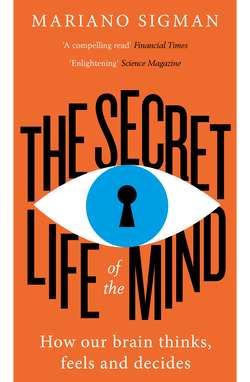The Secret Life of the Mind: How Our Brain Thinks, Feels and Decides

Реклама. ООО «ЛитРес», ИНН: 7719571260.
Оглавление
Mariano Sigman. The Secret Life of the Mind: How Our Brain Thinks, Feels and Decides
Copyright
From the international reviews of The Secret Life of the Mind:
Dedication
INTRODUCTION
CHAPTER ONE. The origin of thought. How do babies think and communicate, and how can we understand them better?
The genesis of concepts
Atrophied and persistent synaesthesias
The mirror between perception and action
Piaget’s mistake!
The executive system
The secret in their eyes
Development of attention
The language instinct
Mother tongue
The children of Babel
A conjecturing machine
The good, the bad and the ugly
He who robs a thief …
The colour of a jersey, strawberry or chocolate
Émile and Minerva’s owl
I, me, mine and other permutations by George
Transactions in the playground, or the origin of commerce and theft
Jacques, innatism, genes, biology, culture and an image
CHAPTER TWO. The fuzzy borders of identity. What defines our choices and allows us to trust other people and our own decisions?
Churchill, Turing and his labryinth
Turing’s brain
Turing in the supermarket
The tell-tale heart
The body in the casino and at the chessboard
Rational deliberation or hunches?
Sniffing out love
Believing, knowing, trusting
Confidence: flaws and signatures
The nature of optimists
Odysseus and the consortium we belong to
Flaws in confidence
Others’ gazes
The inner battles that make us who we are
The chemistry and culture of confidence
The seeds of corruption
The persistence of social trust
To sum up …
CHAPTER THREE. The machine that constructs reality. How does consciousness emerge in the brain and how are we governed by our unconscious?
Lavoisier, the heat of consciousness
Pyschology in the prehistory of neuroscience
Freud working in the dark
Free will gets up off the couch
The interpreter of consciousness
‘Performiments’: freedom of expression
The prelude to consciousness
Why can’t we tickle ourselves?
Why doesn’t the image we’re looking at move when we move our eyes?
How do we know that the voices in our head are ours?
In short: the circle of consciousness
The physiology of awareness
Reading consciousness
Observing the imagination
Shades of consciousness
Do babies have consciousness?
CHAPTER FOUR. Voyages of consciousness (or consciousness tripping) What happens in the brain as we dream; is it possible for us to decipher, control and manipulate our dreams? Altered states of consciousness
Nocturnal elephants
The uroboros plot
Deciphering dreams
Daydreams
Lucid dreaming
Voyages of consciousness
The factory of beatitude
The cannabic frontier
Towards a positive pharmacology
The consciousness of Mr X
The lysergic repertoire
Hoffman’s dream
The past and the future of consciousness
The future of consciousness: is there a limit to mind-reading?
CHAPTER FIVE. The brain is constantly transforming. What makes our brain more or less predisposed to change?
Virtue, oblivion, learning, and memory
The universals of human thought
The illusion of discovery
Learning through scaffolding
Effort and talent
Ways of learning
The OK threshold
The history of human virtue
Fighting spirit and talent: Galton’s two errors
The fluorescent carrot
The geniuses of the future
Memory palace
The morphology of form
A monster with slow processors
Our inner cartographers
Fluorescent triangles
The parallel brain and the serial brain
Learning: a bridge between two pathways in the brain
The repertoire of functions: learning is compiling
Automatizing reading
The ecology of alphabets
The morphology of the word
The two brains of reading
The temperature of the brain
CHAPTER SIX. Educated brains. How can we use what we have learned about the brain and human thought to improve education?
The sound of the letters
Word-tied
What we have to unlearn
The framework of thought
Parallelawhat?
Gestures and words
Good, bad, yes, no, ok
The teaching instinct
(1) Prototeachers
(2) Teaching, naturally
Spikes of culture
Docendo discimus
EPILOGUE
APPENDIX. The geography of the brain
Footnotes. 1: The origin of thought
2: The fuzzy borders of identity
3: The machine that constructs reality
4: Voyages of consciousness (or consciousness tripping)
5: The brain is constantly transforming
6: Educated brains
BIBLIOGRAPHY. 1: The origin of thought
2: The fuzzy borders of identity
3: The machine that constructs reality
4: Voyages of consciousness (or consciousness tripping)
5: The brain is constantly transforming
6: Educated brains
ACKNOWLEDGEMENTS
About the Author
About the Publisher
Отрывок из книги
‘To read minds nowadays, one doesn’t need to be a magician or clairvoyant. As science takes leaps and bounds towards understanding the mysteries of consciousness, Mariano Sigman, one of the most notable neuroscientists of today, has written a book on just this subject’
Revista Nueva
.....
The factory of beatitude
The cannabic frontier
.....